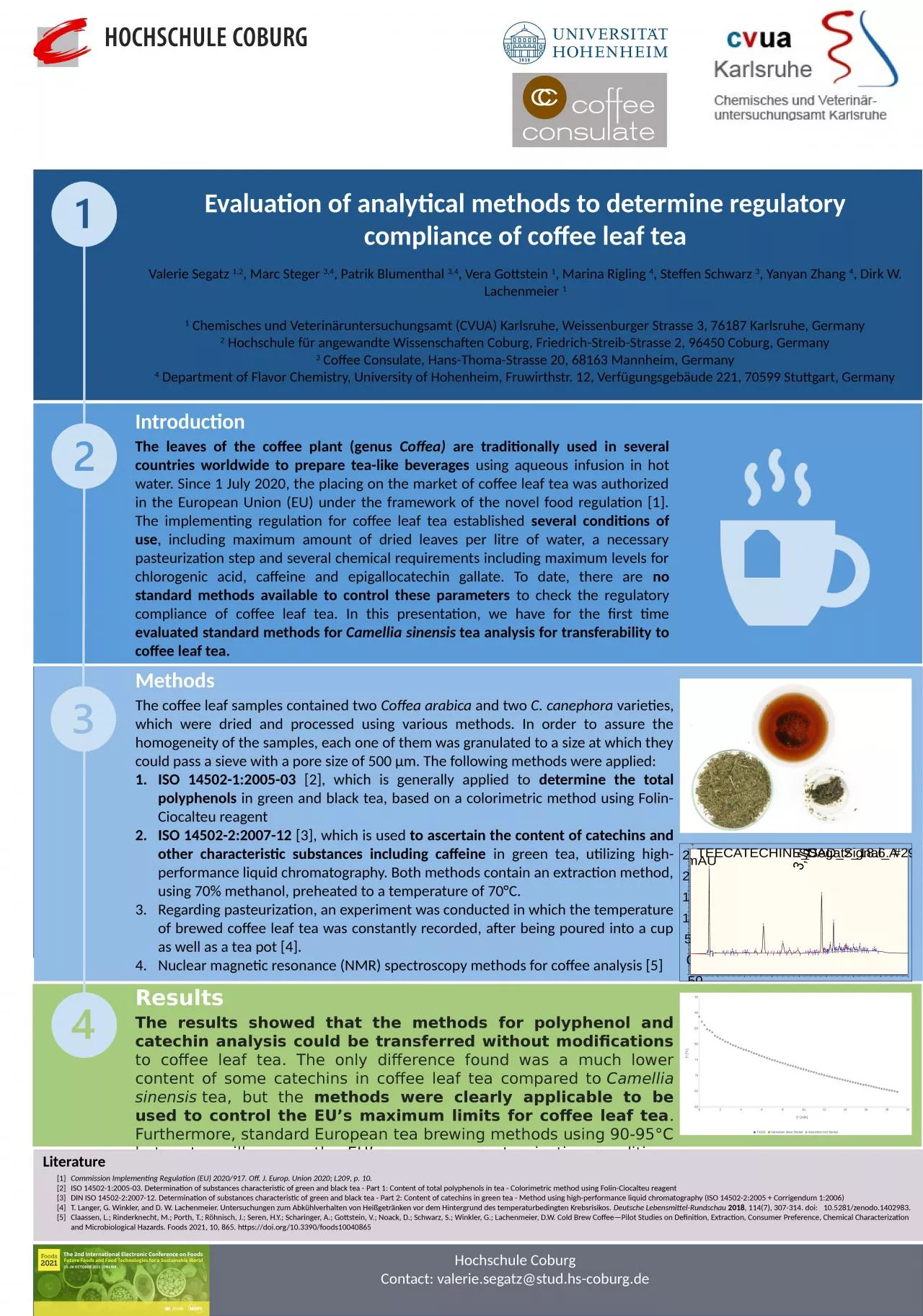

Contact valeriesegatzstudhscoburgde Evaluation of analytical methods to determine regulatory compliance of coffee leaf tea Valerie Segatz 12 Marc Steger ID: 1012041
Download Presentation The PPT/PDF document "14.09.2021 Hochschule Coburg" is the property of its rightful owner. Permission is granted to download and print the materials on this web site for personal, non-commercial use only, and to display it on your personal computer provided you do not modify the materials and that you retain all copyright notices contained in the materials. By downloading content from our website, you accept the terms of this agreement.
1. 14.09.2021Hochschule CoburgContact: valerie.segatz@stud.hs-coburg.deEvaluation of analytical methods to determine regulatory compliance of coffee leaf teaValerie Segatz 1,2, Marc Steger 3,4, Patrik Blumenthal 3,4, Vera Gottstein 1, Marina Rigling 4, Steffen Schwarz 3, Yanyan Zhang 4, Dirk W. Lachenmeier 11 Chemisches und Veterinäruntersuchungsamt (CVUA) Karlsruhe, Weissenburger Strasse 3, 76187 Karlsruhe, Germany2 Hochschule für angewandte Wissenschaften Coburg, Friedrich-Streib-Strasse 2, 96450 Coburg, Germany3 Coffee Consulate, Hans-Thoma-Strasse 20, 68163 Mannheim, Germany4 Department of Flavor Chemistry, University of Hohenheim, Fruwirthstr. 12, Verfügungsgebäude 221, 70599 Stuttgart, GermanyIntroductionThe leaves of the coffee plant (genus Coffea) are traditionally used in several countries worldwide to prepare tea-like beverages using aqueous infusion in hot water. Since 1 July 2020, the placing on the market of coffee leaf tea was authorized in the European Union (EU) under the framework of the novel food regulation [1]. The implementing regulation for coffee leaf tea established several conditions of use, including maximum amount of dried leaves per litre of water, a necessary pasteurization step and several chemical requirements including maximum levels for chlorogenic acid, caffeine and epigallocatechin gallate. To date, there are no standard methods available to control these parameters to check the regulatory compliance of coffee leaf tea. In this presentation, we have for the first time evaluated standard methods for Camellia sinensis tea analysis for transferability to coffee leaf tea. MethodsThe coffee leaf samples contained two Coffea arabica and two C. canephora varieties, which were dried and processed using various methods. In order to assure the homogeneity of the samples, each one of them was granulated to a size at which they could pass a sieve with a pore size of 500 µm. The following methods were applied:ISO 14502-1:2005-03 [2], which is generally applied to determine the total polyphenols in green and black tea, based on a colorimetric method using Folin-Ciocalteu reagentISO 14502-2:2007-12 [3], which is used to ascertain the content of catechins and other characteristic substances including caffeine in green tea, utilizing high-performance liquid chromatography. Both methods contain an extraction method, using 70% methanol, preheated to a temperature of 70°C.Regarding pasteurization, an experiment was conducted in which the temperature of brewed coffee leaf tea was constantly recorded, after being poured into a cup as well as a tea pot [4].Nuclear magnetic resonance (NMR) spectroscopy methods for coffee analysis [5]ResultsThe results showed that the methods for polyphenol and catechin analysis could be transferred without modifications to coffee leaf tea. The only difference found was a much lower content of some catechins in coffee leaf tea compared to Camellia sinensis tea, but the methods were clearly applicable to be used to control the EU’s maximum limits for coffee leaf tea. Furthermore, standard European tea brewing methods using 90-95°C hot water will ensure the EU’s necessary pasteurization conditions (at least 71°C for 15 seconds).Literature[1] Commission Implementing Regulation (EU) 2020/917. Off. J. Europ. Union 2020; L209, p. 10. [2] ISO 14502-1:2005-03. Determination of substances characteristic of green and black tea - Part 1: Content of total polyphenols in tea - Colorimetric method using Folin-Ciocalteu reagent[3] DIN ISO 14502-2:2007-12. Determination of substances characteristic of green and black tea - Part 2: Content of catechins in green tea - Method using high-performance liquid chromatography (ISO 14502-2:2005 + Corrigendum 1:2006) [4] T. Langer, G. Winkler, and D. W. Lachenmeier. Untersuchungen zum Abkühlverhalten von Heißgetränken vor dem Hintergrund des temperaturbedingten Krebsrisikos. Deutsche Lebensmittel-Rundschau 2018, 114(7), 307-314. doi: 10.5281/zenodo.1402983. [5] Claassen, L.; Rinderknecht, M.; Porth, T.; Röhnisch, J.; Seren, H.Y.; Scharinger, A.; Gottstein, V.; Noack, D.; Schwarz, S.; Winkler, G.; Lachenmeier, D.W. Cold Brew Coffee—Pilot Studies on Definition, Extraction, Consumer Preference, Chemical Characterization and Microbiological Hazards. Foods 2021, 10, 865. https://doi.org/10.3390/foods10040865